2. 水利部松辽水利委员会水土保持处, 130021, 长春;
3. 水利部松辽水利委员会松辽流域水土保持监测中心站, 130021, 长春;
4. 吉林省水土保持局, 130022, 长春
中国水土保持科学  2018, Vol. 16 2018, Vol. 16  Issue (6): 24-30. DOI: 10.16843/j.sswc.2018.06.004 Issue (6): 24-30. DOI: 10.16843/j.sswc.2018.06.004 |
东北黑土区是我国最大商品粮生产基地[1-2],但土壤质地疏松、抗蚀性较差,在水力侵蚀作用下,面蚀发展到一定程度,就会在汇水线上形成侵蚀沟[3]。第1次全国水利普查(2010)[4]指出,东北黑土区100m以上的侵蚀沟有29.57万余条,占地面积3648km2。侵蚀沟带来多方面危害[5]:严重破坏土地资源[6];造成泥沙下泄,影响库塘安全和水质[7];使耕地支离破碎,形成弃耕地[5]。近年来,随着空间信息技术的应用,黑土区侵蚀沟动态变化识别、水土保持防控措施配置取得了明显进展[6-8];但极其缺乏侵蚀沟危害范围方面研究成果[9],给政府决策、侵蚀沟防治规划制定带来很大困难[10]。鉴于此,笔者将在界定侵蚀沟危害黑土地面积范围的基础上,开展侵蚀沟汇水区流域边界识别,进而初步解析不同类型侵蚀沟危害面积特征。
1 研究区概况东北黑土区包括黑龙江省、吉林省全部,以及辽宁省和内蒙古自治区部分区域,总面积为109万km2[2],如图 1所示。区域地形复杂,以漫岗丘陵为主,夏季降雨集中,冬季漫长,冻融交替明显。经过100余年的高强度开发,区域耕地面积急剧上升,0.5°~5°的坡耕地占黑土区耕地总面积的56%。耕作方式粗放、保护性耕作措施不到位,造成水土流失不断恶化。
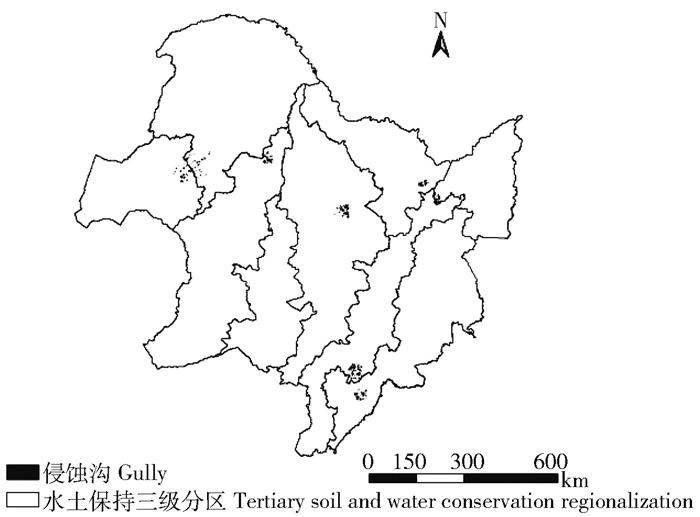
|
图 1 东北侵蚀沟样本空间分布 Fig. 1 Spatial distribution of gully samples in Northeast China |
坡面侵蚀是一个逐渐发展演化的过程[11]。在降雨初期,由于雨滴击溅和坡面薄层水流侵蚀的作用,坡面上主要发生片蚀和面蚀[12];随着降雨过程的进行,坡面逐渐出现跌坎并发展演化成细沟,随着细沟的发育发展,细沟侵蚀逐渐向浅沟、切沟、冲沟演变[13-14]。本文中提及的侵蚀沟主要是指危害程度较大的切沟与冲沟。
2.2 东北黑土区面蚀与沟蚀关系面蚀可诱发沟蚀,二者相互促进、相互制约,沟蚀弱则减缓面蚀的发展,沟蚀强可加速面蚀的发展。侵蚀沟形成于汇水线上,受汇水面积、降雨径流、坡长、植被及土壤理化性状影响[15]。侵蚀沟形成后,通过溯源向上游较快扩展,也会向下游发展;同时,最初形成的V形沟在冻融、重力侵蚀复合作用下也会快速向两侧扩展。
2.3 侵蚀沟影响范围侵蚀沟的影响范围根据危害程度不同分为直接影响区、间接影响区与汇水区。直接影响区就是沟缘/沿的投影区域,即沟道本身,这一区域坡度大,黑土层流失殆尽,母质裸露,已无法进行耕种。间接影响区是指沟道两侧3~10m范围内农业机械难以耕作而弃耕的区域,其面积与侵蚀沟大小直接相关。侵蚀沟对其汇水区的影响一方面体现造成侵蚀基准面下移,诱发面蚀[6],另一方面汇水区内径流、泥沙以侵蚀沟为通道输出到下游河道[7]。
相对于黄土区,东北黑土区开发较晚,因此多数侵蚀沟形成时间较短[9]。溯源侵蚀速度明显快于沟尾向坡下延展速度,沟口尚未到达下一级沟道或溪流,其汇水区面积在长时间尺度下是会变化的。因此笔者在估算侵蚀沟危害面积时考虑了时间因素的影响(图 2),认为其影响范围包括现状汇水区(S2)(直接影响区与间接影响区在其中),指目前沟头(A1)至沟口(A2)间区域,潜在汇水区(S1+S3),指目前沟头(A1)以上至分水岭部分及最终沟口(A3)至实际沟口A2之间区域。
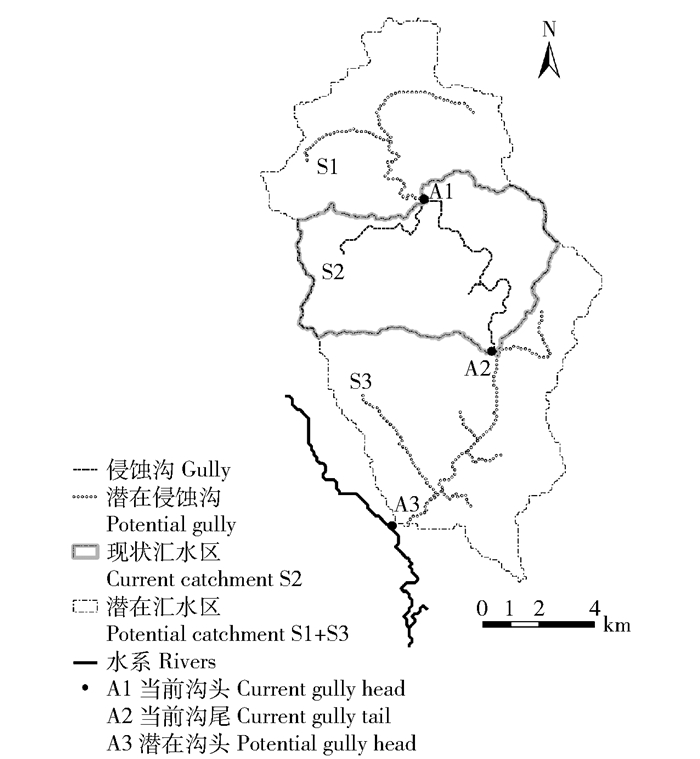
|
图 2 侵蚀沟的现状汇水区和潜在汇水区示意图 Fig. 2 Current and potential catchments of gullies |
不合理的耕作方式(如顺垄种植等)可能导致当前沟头以上区域可能有径流汇入;但这部分集水区面积较小,也很难定量识别,因此在本文的现状汇水区中并没有考虑这部分面积。由于本研究关注的是长时间尺度下,侵蚀沟完全发育所危害的范围,即危害面积S=潜在汇水区面积(S1+S3)+现状汇水区面积(S2)。该概念已包括可能向侵蚀沟汇水的所有面积,因此现状汇水面积的微小变化,并不对最终结果产生影响。
3 侵蚀沟危害面积识别方法 3.1 数据来源与处理研究采用空间分辨率30m数字高程模型(DEM),来源于中科院计算机网络信息中心地理空间数据云平台;空间分辨率10m DEM数据,由等高距为10m的1:5万地形图过矢量化空间插值方法获得,投影为通用横轴墨卡托投影(universal transverse mercator, UTM), 格式为TIFF。侵蚀沟矢量数据来源于第1次水利普查成果[16],由水利部松辽水利委员会提供。
侵蚀沟选取主要依据为黑土区水土保持三级区划[17]与侵蚀沟治理示范工程的所在地位置:要覆盖9个水土保持分区,保证空间上代表性,同时还要位于治理工程区域内,便于数据收集及后期成果验证。但侵蚀沟在不同水保分区内的空间聚集程度不同,且治理工程所在区域的位置也存在一定随机性,所以侵蚀沟样本(共计460条)空间分布有些不均匀。侵蚀沟类型划分主要依据黑土区侵蚀沟治理专项规划(2016—2030年)中提出的分级规则[18]:侵蚀沟占地面积(投影面积)小于0.3hm2的为小型沟;占地面积介于0.3~1.4hm2的为中型沟;占地面积大于1.4hm2的为大型沟。
3.2 侵蚀沟汇水面积识别侵蚀沟作为潜在的低级别汇流河道,其发生、发展直接受区域地形的影响[19],因此本研究将采用刻画流域水系的方法,进行侵蚀沟汇水区边界的确定与危害面积识别[19-20],主要过程分为3部分,技术流程见图 3。
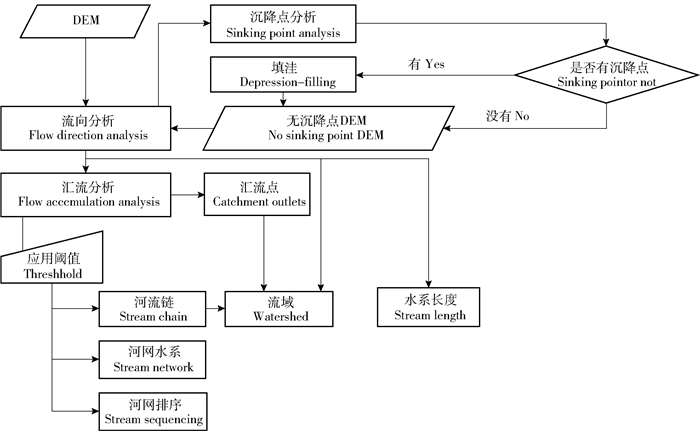
|
图 3 侵蚀沟汇水边界识别过程 Fig. 3 Identification process of gully catchment boundary |
识别DEM栅格单元的径流方向是进行水文分析的基础[21]。D8是一种实用算法,并得到国内外广泛的应用,效果比较稳定。该算法中,径流方向定义为东北、东、东南、南、西南、西、西北和北,并分别用128、1、2、4、8、16、32和64这8个有效特征码表示(见图 4)[22]。
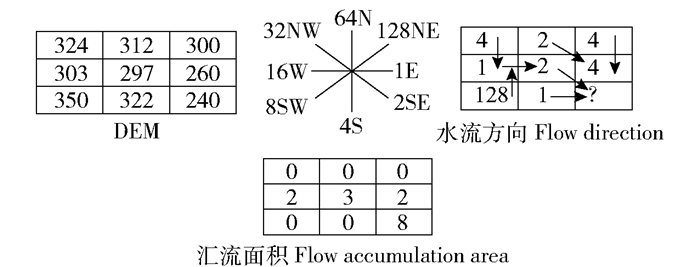
|
图 4 D8算法示意图 Fig. 4 D8 algorithm diagram |
被处理栅格单元同相邻8个栅格单元之间坡降的算法为
| $ {\rm{Slope}} = {D_z}/{D_i}。$ | (1) |
式中:Slope为2个栅格之间的坡降;Dz为2个栅格单元之间的高程差,m;Di为2个栅格单元中心之间的距离,m。
3.2.2 集水能力分析栅格的集水能力通常用汇流能力表征,反映了该栅格收集地表径流的能力的大小,栅格的汇流特征值代表其最多接受周围来水的栅格数目,数值越大,说明能够汇入其中径流的栅格数目越多,产流的可能性更高。
3.2.3 集水区划分与河流网络生成依据栅格汇流能力刻画区域集水区域及其边界(分水岭)(集水区边界)。汇流特征值≥1的栅格就可划分为集水区,特征值为0的则代表流域的分水岭区域。
4 结果与分析 4.1 数据精度影响从表 1可以看出,以10m精度DEM刻画结果为基准,侵蚀沟样本的汇水面积的平均误差在±16.04%左右,其中面积识别误差较小的是大型侵蚀沟,这一类型侵蚀沟多集中集中在地形起伏较大的高山区,水流方向判别较为容易,所以数据精度带来的误差较小。而小型侵蚀沟更多的分布于漫坡慢岗区域,地势低平,地形多变,数据精度对于水流方向的判断影响较大,因此小型沟的识别结果误差相对较大。图 5展示了基于不同精度DEM识别同一侵蚀沟汇水边界的几何形状,从汇水边界的形状差异来看,数据精度带来的识别误差是可以接受的。
| 表 1 不同类型侵蚀沟危害面积 Tab. 1 Damaged areas of different types of gullies |
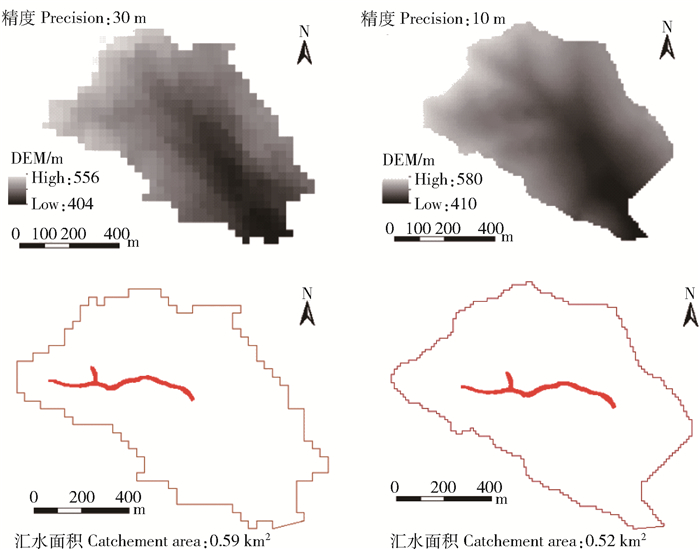
|
图 5 丘陵区中型沟汇水面积识别结果(沟道占地面积0.77ha,沟长648.5m) Fig. 5 Identification result of catchment areas of medium-size gullies in the hilly area(Projected gully area 0.77hm2 and its length 648.5m) |
不同类型侵蚀沟危害面积差异较为明显,如表 1所示。中型沟的危害面积是小型沟1.5倍,而大型沟的危害面积超过了小型沟3倍以上。但图 6显示不同类型侵蚀沟的潜在危害面积比例却拥有正相反的变化趋势,小型沟的潜在危害面积比例达到76.19%,中型沟潜在危害面积占比超过了50%,而大型沟基本没有潜在危害面积,潜在危害性不大。
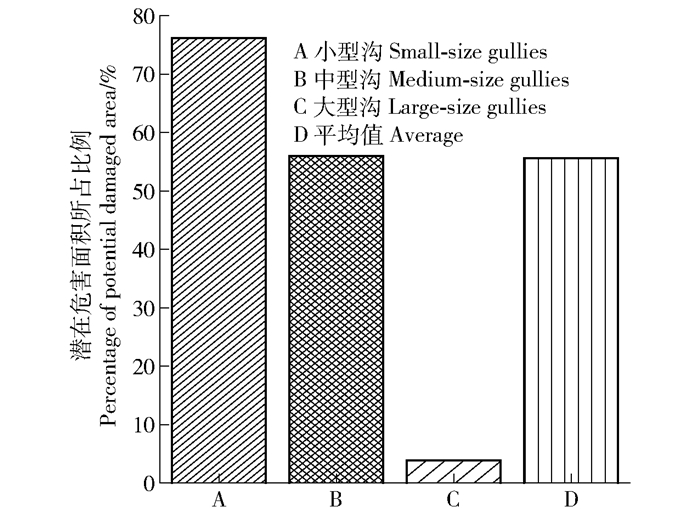
|
图 6 不同类型侵蚀沟潜在危害面积比例 Fig. 6 Percentages of potential damaged areas of different gullies |
图 6显示侵蚀沟的长度与其危害面积的相关程度要比其占地面积与危害面积的相关程度高。这主要是由于侵蚀沟长度的变化主要是受流域内地形、坡度的影响,而占地面积(投影面积)的变化则受到地形、耕作措施的综合影响,因此导致以汇水面积为基础的侵蚀沟危害面积与侵蚀沟长度相关性更好。将建立的侵蚀沟长度与危害面积的定量关系引入实际工作中,将有利于减轻管理部门的工作量,提高工作效率。
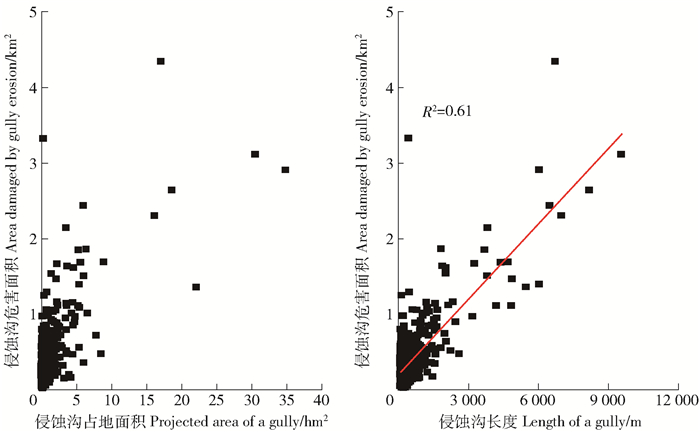
|
图 7 侵蚀沟特征与危害面积关系 Fig. 7 Relationship between gully feature and damaged area |
1) 侵蚀沟危害面积以“汇水面积”为基础,既反映了侵蚀沟对不同空间尺度区域的影响(直接影响区、间接影响区与汇水区),又首次表征了长时间尺度上侵蚀沟发育带来的危害(现状汇水区与潜在汇水区),符合东北黑土区实际情况。
2) 侵蚀沟危害范围识别方法对数据精度要求适中,30m数字高程模型(DEM)数据与第1次水利普查侵蚀沟矢量数据相匹配就能够满足黑土区侵蚀沟汇水边界识别需要。
3) 不同类型的侵蚀沟危害面积差异明显。虽然大型沟危害面积显著大于中小型沟,但后者潜在危害面积所占比例非常高,应作为未来黑土区侵蚀沟治理的重点。
| [1] |
刘兴土, 阎百兴. 东北黑土区水土流失与粮食安全[J].
中国水土保持, 2009(1): 17.
LIU Xingtu, YAN Baixing. Soil andwater loss and grain security of black soil region in Northeast China[J]. Soil and Water Conservation in China, 2009(1): 17. DOI: 10.3969/j.issn.1000-0941.2009.01.006. |
| [2] |
刘宝元, 阎百兴, 沈波, 等. 东北黑土区农地水土流失现状与综合治理对策[J].
中国水土保持科学, 2008, 6(1): 1.
LIU Baoyuan, YAN Baixing, SHEN Bo, et al. Current status and comprehensive control strategies of soil erosion for cultivated land in the northeastern black soil area of China[J]. Science of Soil and Water Conservation, 2008, 6(1): 1. DOI: 10.3969/j.issn.1672-3007.2008.01.001. |
| [3] |
许晓鸿, 隋媛媛, 张瑜, 等. 东北丘陵区沟蚀发展现状及影响因素分析[J].
土壤学报, 2014, 51(4): 699.
XU Xiaohong, SUI Yuanyuan, ZHANG Yu, et al. Development of gully erosion and its influencing factors in hilly regions of Northeast China[J]. Acta Pedologica Sinica, 2014, 51(4): 699. |
| [4] |
中华人民共和国水利部. 第一次全国水利普查水土保持情况公报[J].
中国水土保持, 2013(10): 2.
Ministry of Water Resources (MWR), the People's Republic of China. Bulletin of soil and water conservation survey in national census for water resource[J]. Soil and Water Conservation in China, 2013(10): 2. DOI: 10.3969/j.issn.1000-0941.2013.10.003. |
| [5] |
白建宏, 回莉君. 东北黑土区侵蚀沟发展与危害初步调查[J].
中国水土保持, 2015(8): 68.
BAI Jianhong, HUI Lijun. Preliminary investigation on development and damage of gullies in black soil area of Northeast China[J]. Soil and Water Conservation in China, 2015(8): 68. DOI: 10.3969/j.issn.1000-0941.2015.08.024. |
| [6] |
于章涛, 伍永秋. 黑土地切沟侵蚀的成因与危害[J].
北京师范大学学报(自然科学版), 2003, 39(5): 701.
YU Zhangtao, WU Yongqiu. Causes and damages of gully erosion in black land[J]. Journal of Beijing Normal University (Natural Science), 2003, 39(5): 701. DOI: 10.3321/j.issn:0476-0301.2003.05.025. |
| [7] |
OU Yang, ROUSSEAU A N, WANG Lixia, et al. Spatio-temporal patterns of soil organic carbon and pH in relation to environmental factors:A case study of the Black Soil Region of Northeastern China[J].
Agriculture Ecosystems & Environment, 2017, 245: 22.
|
| [8] |
张永光, 伍永秋, 刘洪鹄, 等. 东北漫岗黑土区地形因子对浅沟侵蚀的影响分析[J].
水土保持学报, 2007, 21(1): 35.
ZHANG Yongguang, WU Yongqiu, LIU Honghu, et al. Effect of topography on ephemeral gully erosion in Northeast China with black soils[J]. Journal of Soil and Water Conservation, 2007, 21(1): 35. DOI: 10.3321/j.issn:1009-2242.2007.01.009. |
| [9] |
范昊明, 顾广贺, 王岩松, 等. 东北黑土区侵蚀沟发育与环境特征[J].
中国水土保持, 2013(10): 75.
FAN Haoming, GU Guanghe, WANG Yansong, et al. Characteristics of eroded gully development and environment of black soil region in Northeast China[J]. Soil and Water Conservation in China, 2013(10): 75. DOI: 10.3969/j.issn.1000-0941.2013.10.021. |
| [10] |
张琳.东北黑土区漫川漫岗区侵蚀沟评价指标体系[D].长春: 东北师范大学, 2013: 10.
ZHANG Lin. The erosion gully evaluation index system of the diffuse gentle hilly area of the Northeast black soil area[D]. Changchun: Northeast Normal University, 2013: 10. http://cdmd.cnki.com.cn/Article/CDMD-10200-1013363667.htm |
| [11] |
汪晓勇, 郑粉莉, 张新和. 上方汇流对黄土坡面侵蚀-搬运过程的影响[J].
中国水土保持科学, 2009, 7(2): 7.
WANG Xiaoyong, ZHENG Fenli, ZHANG Xinhe. Effects of upslope runoff on detachment and transport processes on loessial hillslopes[J]. Journal of Soil and Water Conservation, 2009, 7(2): 7. DOI: 10.3969/j.issn.1672-3007.2009.02.002. |
| [12] |
武敏.坡面汇流汇沙与浅沟侵蚀过程研究[D].陕西杨凌: 西北农林科技大学, 2005: 14.
WU Min. Effects of up-slope runoff and sediment on shallow gully erosion process at Loess hillslopes[D]. Yangling in Shaanxi: Northwest A&F University, 2005: 14. http://cdmd.cnki.com.cn/Article/CDMD-10712-2005111202.htm |
| [13] |
伍永秋, 刘宝元. 切沟、切沟侵蚀与预报[J].
应用基础与工程科学学报, 2000, 8(2): 134.
WU Yongqiu, LIU Baoyuan. Gully, gully erosion and prediction[J]. Journal of Basic Science and Engineering, 2000, 8(2): 134. DOI: 10.3969/j.issn.1005-0930.2000.02.004. |
| [14] |
雷阿林, 唐克丽, 王文龙. 土壤侵蚀链概念的科学意义及其特征[J].
水土保持学报, 2000, 14(3): 79.
LEI Alin, TANG Keli, WANG Wenlong. Significance and character of conception of soil erosion Chain[J]. Journal of Soil and Water Conservation, 2000, 14(3): 79. DOI: 10.3321/j.issn:1009-2242.2000.03.017. |
| [15] |
ALLEN P M, ARNOLD J G, AUGUSTE L, et al. Application of a simple headcut advance model for gullies[J].
Earth Surface Processes & Landforms, 2018, 43(1): 202.
|
| [16] |
李智广, 王岩松, 刘宪春, 等. 我国东北黑土区侵蚀沟道的普查方法与成果[J].
中国水土保持科学, 2013, 11(5): 9.
LI Zhiguang, WANG Yansong, LIU Xianchun, et al. Survey methods and results of erosion gullies in black soil areas of northeastern China[J]. Science of Soil and Water Conservation, 2013, 11(5): 9. DOI: 10.3969/j.issn.1672-3007.2013.05.002. |
| [17] |
王治国, 张超, 孙保平, 等. 全国水土保持区划概述[J].
中国水土保持, 2015(12): 12.
WANG Zhiguo, ZHANG Chao, SUN Baoping, et al. Overview of national soil and water conservation zoning[J]. Soil and Water Conservation in China, 2015(12): 12. DOI: 10.3969/j.issn.1000-0941.2015.12.006. |
| [18] |
白建宏. 东北黑土区侵蚀沟分级初探[J].
中国水土保持, 2017(10): 41.
BAI Jianhong. Study on classification of gullies in black soil area of Northeast China[J]. Soil and Water Conservation in China, 2017(10): 41. DOI: 10.3969/j.issn.1000-0941.2017.10.014. |
| [19] |
母红丽, 邓青春, 刘辉, 等. 元谋干热河谷冲沟长度与汇水面积的关系[J].
四川林勘设计, 2014(2): 10.
MU Hongli, DENG Qingchun, LIU Hui, et al. Relationship between length and catchment area of gullies in the Yuanmou Dry-hot Valley[J]. Sichuan Forestry Exploration and Design, 2014(2): 10. |
| [20] |
ROUSSEAU A N, MARTIN M N M, SAVARY S, et al. An algorithm for determining potential rill areas from gridded elevation data: Development and integration in a vegetated filter dimensioning model[C]. AGU Fall Meeting, 2014, December: 2.
|
| [21] |
ORLANDINI S, MORETTI G. Determination of surface flow paths from gridded elevation data[J].
Water Resources Research, 2009, 45(3): 150.
|
| [22] |
张维, 杨昕, 汤国安, 等. 基于DEM的平缓地区水系提取和流域分割的流向算法分析[J].
测绘科学, 2012, 37(2): 94.
ZHANG Wei, YANG Xin, TANG Guoan, et al. DEM-based flow direction algorithms study of stream extraction and watershed delineation in the low relief areas[J]. Science of Surveying and Mapping, 2012, 37(2): 94. |